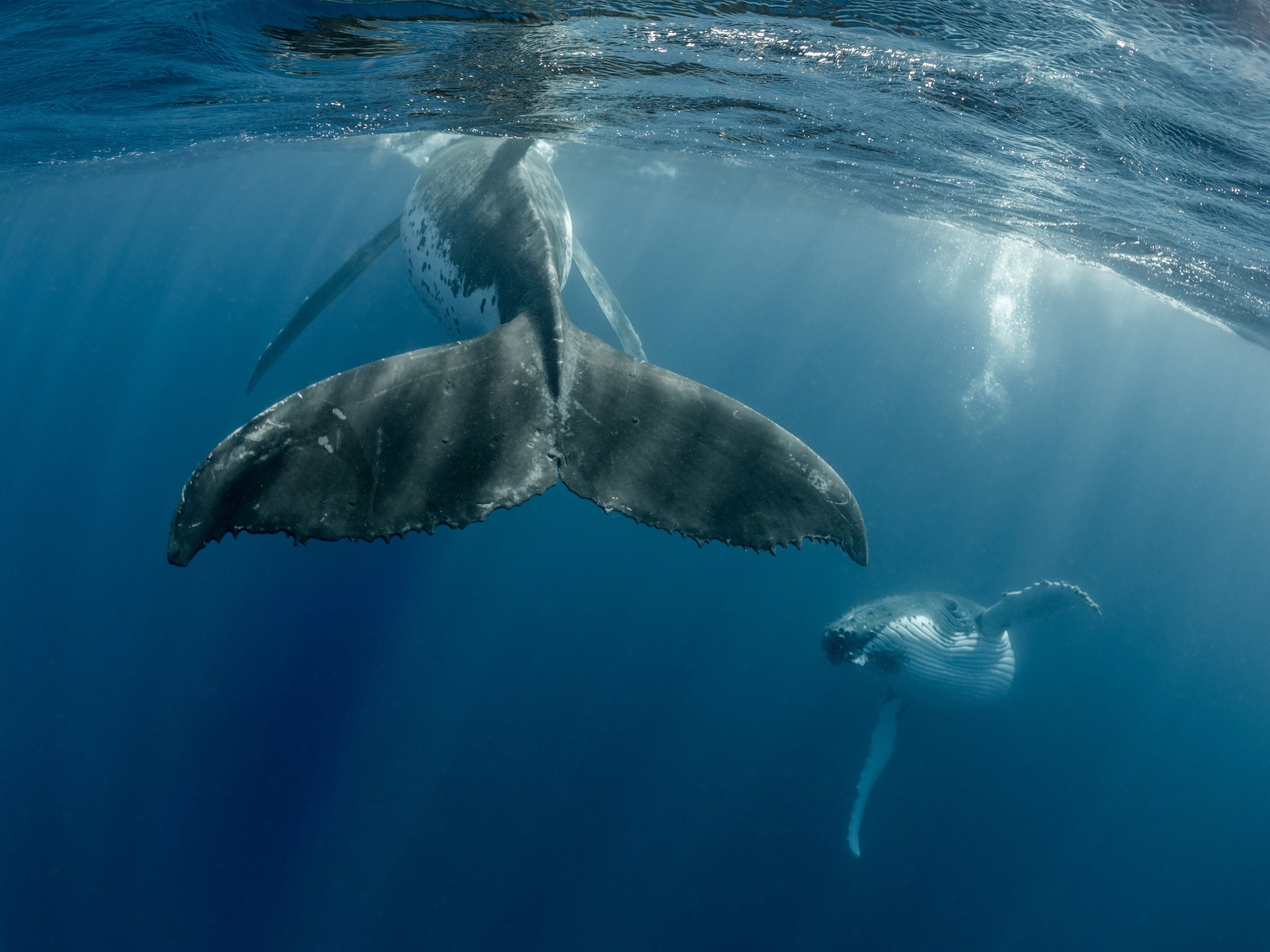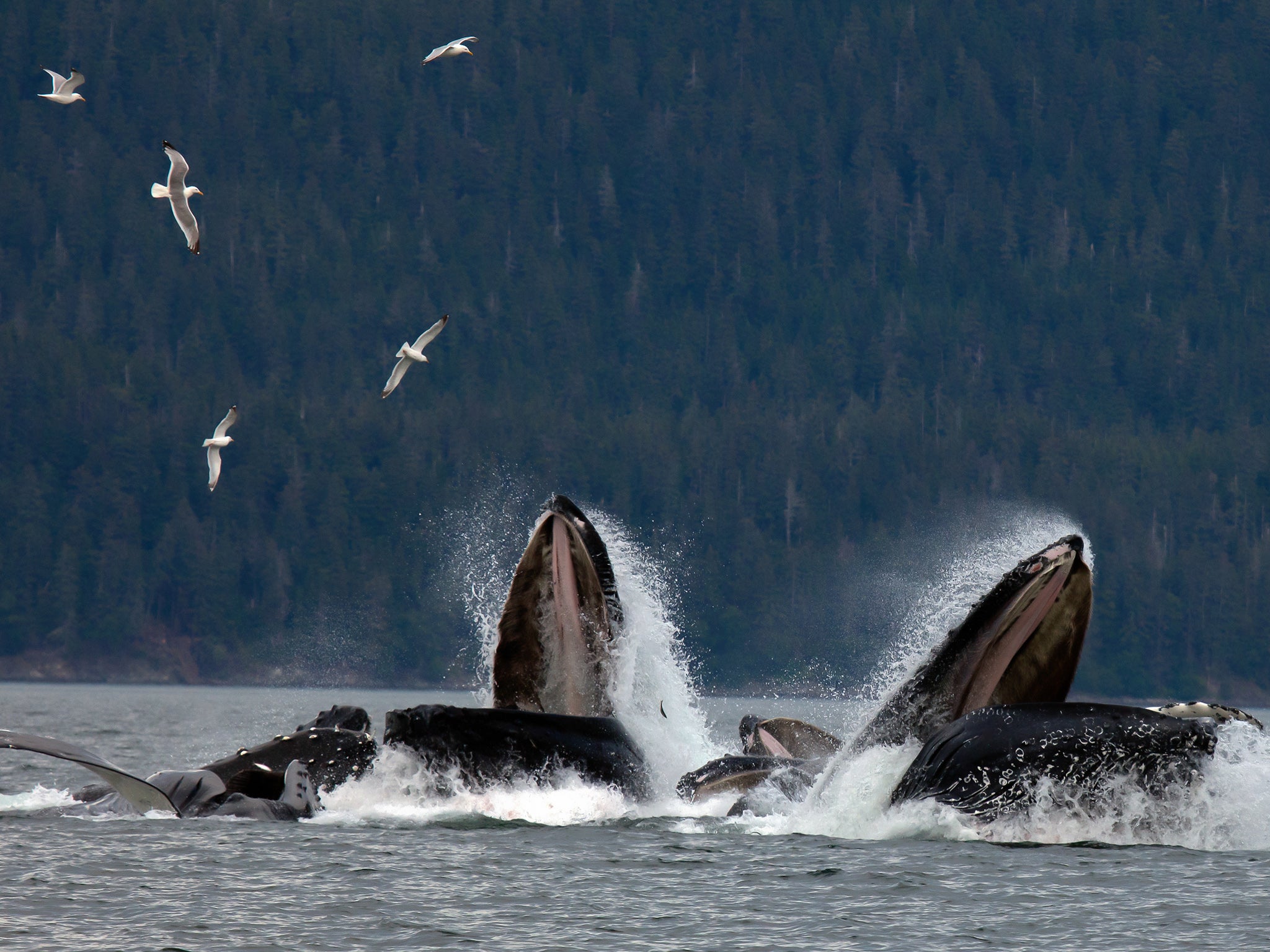From the humpback to the Antarctic blue: why do whales sing?
Scientists have long been puzzled as to why the mammals communicate through song – and now many are singing at a lower pitch than before. Karen Weintraub rides a new wave of research

Your support helps us to tell the story
From reproductive rights to climate change to Big Tech, The Independent is on the ground when the story is developing. Whether it's investigating the financials of Elon Musk's pro-Trump PAC or producing our latest documentary, 'The A Word', which shines a light on the American women fighting for reproductive rights, we know how important it is to parse out the facts from the messaging.
At such a critical moment in US history, we need reporters on the ground. Your donation allows us to keep sending journalists to speak to both sides of the story.
The Independent is trusted by Americans across the entire political spectrum. And unlike many other quality news outlets, we choose not to lock Americans out of our reporting and analysis with paywalls. We believe quality journalism should be available to everyone, paid for by those who can afford it.
Your support makes all the difference.Sometimes a whale just wants to change its tune. That’s one of the things researchers have learnt recently by eavesdropping on whales in several parts of the world and listening for changes in their pattern and pitch. Together, the new studies suggest that whales are not just whistling in the water, but constantly evolving a form of communication that we are only beginning to understand.
Most whales and dolphins vocalise, but dolphins and toothed whales mostly make clicking and whistling sounds. Humpbacks, and possibly bowheads, sing complex songs with repeated patterns, says Michael Noad, an associate professor in the Cetacean Ecology and Acoustics Laboratory at the University of Queensland in Australia.
Birds may broadcast their social hierarchy among song-sharing populations by allowing the dominant bird to pick the playlist and patterns. But how and why whales pass song fragments across hundreds of miles, and to thousands of animals, is far more mysterious.
The biggest question is why whales sing at all.
“The thing that always gets me out of bed in the morning is the function of the song,” Noad says. “I find humpback song fascinating from the point of view of how it’s evolved.”
The leading hypothesis is that male humpbacks – only the males sing – are trying to attract females. But they may also switch tunes when another male is nearby, apparently to assess a rival’s size and fitness, says Noad, who was the senior author of one of four new papers on whale songs.
Why the humpbacks’ musical patterns tend to be more complex than those of other whales is also a bit murky. Noad suggests that the development may be the result of “runaway selection”.
Early humpbacks with complex songs were so much more successful at mating that they gained a substantial evolutionary advantage over their brethren with simpler vocalisations. This led to some very large, sometimes very noisy animals.
Julien Bonnel, an associate scientist at the Woods Hole Oceanographic Institution in Massachusetts, says the growing research also shows the importance of collecting data over many years, offering insights not only into whales but ocean conditions that affect other species.
The technology for recording whales has become much cheaper over the last dozen years or so, making it more accessible to researchers. And computer programmes that analyse huge data sets quickly have helped interpret years of these recordings.

Tagging whales without hurting them has produced more data, Noad notes, but the tags remain on the whale only for a few hours, limiting the information that can be collected.
In one of the new studies, led by scientists at the New York-based Wildlife Conservation Society, researchers tracked humpbacks singing along the east and west coasts of Africa, comparing songs sung by those off the coast of Gabon to those near Madagascar.
The study, published in the journal Royal Society Open Science, confirmed that the two populations interact, noting overlap in their vocalisations. The researchers recorded songs annually from 2001 to 2005 using hand-held hydrophones aboard boats.
“Male humpback whales within a population tend to sing the same song type, but it’s continuously changing and evolving over time,” says Melinda Rekdahl, the study’s first author and a marine conservation scientist with the wildlife society. “It’s thought to be one of the best examples of cultural evolution in the animal kingdom.”
Rekdahl wasn’t on the boat that collected the sound for her new study, but she knows firsthand that “it can be an amazing experience”, she says.
You can often sit there for hours recording and hearing the song through your headphones but not see a whale anywhere
The sound of a nearby singer resonates through the hull of the boat. “If the singer is that close, you can hear the song getting fainter just before the whale surfaces nearby,” she recalls.
“If the singers aren’t that close,” she adds, “you can often sit there for hours recording and hearing the song through your headphones but not see a whale anywhere.”
Rekdahl based her new study on data collected between 2001 and 2005, because she thought those recordings offered the best opportunity to compare song similarities between neighbouring populations.
The idea of using songs to look at population mixing and connectivity is relatively new, she says, and has been proven valuable only in the past few years.
Some animals repeat sounds more than others, some sing “aberrant” tunes, and juveniles may hum jingles altogether different from the adults. Humpbacks also alter their tunes over time.
One reason might be novelty – for themselves or nearby females. “If I was swimming up with 15,000 whales and all the males were singing the same song, it would drive me crazy,” Rekdahl says. Maybe the “females are just, like, give me a new song!”
Two additional recent studies examined how the songs change, seasonally and across years. In one paper, Jenny Allen, who was a doctoral student with Noad, found an unexpected pattern among humpbacks. Once their songs reach a certain level of complexity, humpbacks drop that tune entirely and pick up a new, simpler one. Her study, the first to quantify the complexity of the songs, was published in Proceedings of the Royal Society B: Biological Sciences.
“That clear oscillating pattern was something we didn’t really expect,” says Allen, now a postdoctoral researcher at the University of Queensland and a lecturer at Griffith University in Australia.
Assuming that the songs are meant to attract females, “it might be that a brand-new song is a bit sexier than continuing to sing the complicated version of the old song”, she says. But because it’s hard to memorise a whole new song, “they’re simplifying it to make it easy to learn so much new material all at once”.
Humpback songs have a lot of repeating patterns, which might make them easier to remember, just as rhymes at the end of poetry lines aid memorisation, Allen says. She also found a lot of predictability in the patterns, and compared them to pop songs based on the same four chords.
In another new paper, researchers at the University of Brest in France found that the pitch of Antarctic blue whale, pygmy blue whale and fin whale vocalisations fell from 2007 to 2016 at various recording sites in the southern Indian Ocean.
Because of a whale’s anatomy, a louder call is higher in pitch, and a quieter one is lower. Essentially, the whales have gotten slightly quieter, says Emmanuelle Leroy, now a research fellow at the University of New South Wales and an author of the new research.

“Blue whales are mostly solitary, so to communicate across large distance, they need to produce really low-frequency and high-intensity calls,” she says. “The calls are really loud and will propagate over a few hundreds of kilometres.”
Her team has two hypotheses to explain the drop in pitch across years. With the populations rebounding since the end of commercial whaling, perhaps the whales don’t need their calls to carry as far to be heard by others.
Or perhaps with oceans acidifying because of climate change, the calls are naturally carrying farther, allowing the whales to reduce their volume. The team does not believe the change in pitch is tied directly to human activity.
Their research, published in the Journal of Geophysical Research: Oceans, also showed that the call pitch of the Antarctic blue whales varies across seasons, with pitches increasing 0.1 hertz during the spring and summer and dropping at other times.
That might be the whales’ response to the loud cleaving of icebergs in the spring and summer. These extremely loud sounds – like the cracking of ice in a glass – make it harder for the whales to hear one another, so they crank up the volume, Leroy says.
Noad thinks the overall drop in pitch could be a reflection of the ageing of the population, with older whales making deeper sounds.
Contrary to other scientists, he also believes that whales can hear human-made noises from quite a distance, in the same way that people in urban environments can hear the distant rumble of traffic even if there are no cars passing directly by.
Humpback whales have made a “really nice comeback” since commercial whaling was largely stopped in the 1960s, Noad says. But for unknown reasons, blue and fin whales are still struggling; just a few thousand Antarctic blue whales remain.
In yet another new study related to whale song, researchers at Woods Hole found that short-finned pilot whales living off the coast of Hawaii have their own vocal dialects, suggesting that different groups are purposely avoiding one another.
Relatively little is known about this species’ behaviour. The new studies provide a better sense of the social ties between whale groups, which could promote understanding of their genetic diversity and evolution, as well as conservation, the researchers say.
© New York Times
Join our commenting forum
Join thought-provoking conversations, follow other Independent readers and see their replies
Comments